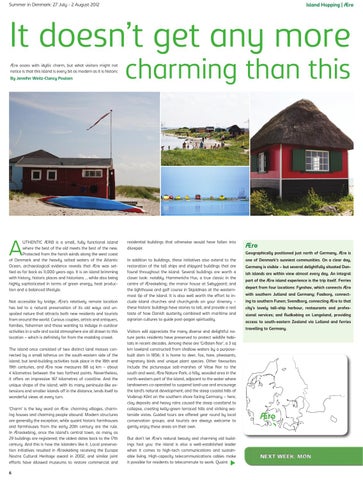Island Hopping | Ærø
Summer in Denmark: 27 July - 2 August 2012
It doesn’t get any more Ærø oozes with idyllic charm, but what visitors might not notice is that this island is every bit as modern as it is historic By Jennifer Weitz-Clancy Poulsen
A
UTHENTIC ÆRØ is a small, fully functional island where the best of the old meets the best of the new. Protected from the harsh winds along the west coast of Denmark and the heavily salted waters of the Atlantic Ocean, archaeological evidence reveals that Ærø was settled as far back as 11,000 years ago. It is an island brimming with history, historic places and historians … while also being highly sophisticated in terms of green energy, heat production and a balanced lifestyle. Not accessible by bridge, Ærø’s relatively remote location has led to a natural preservation of its old ways and unspoiled nature that attracts both new residents and tourists from around the world. Curious couples, artists and antiquers, families, fishermen and those wanting to indulge in outdoor activities in a safe and social atmosphere are all drawn to this location – which is definitely far from the madding crowd. The island once consisted of two distinct land masses connected by a small isthmus on the south-eastern side of the island, but land-building activities took place in the 18th and 19th centuries, and Ærø now measures 88 sq km – about 4 kilometres between the two farthest points. Nevertheless, it offers an impressive 167 kilometres of coastline. And the unique shape of the island, with its many peninsula-like extensions and smaller islands off in the distance, lends itself to wonderful views at every turn. ‘Charm’ is the key word on Ærø: charming villages, charming houses and charming people abound. Modern structures are generally the exception, while quaint historic farmhouses and farmhouses from the early 20th century are the rule. In Ærøskøbing, once the island’s central town, as many as 29 buildings are registered; the oldest dates back to the 17th century. And this is how the islanders like it. Local preservation initiatives resulted in Ærøskøbing receiving the Europa Nostra Cultural Heritage award in 2002, and similar joint efforts have allowed museums to restore commercial and
6
charming than this
residential buildings that otherwise would have fallen into disrepair.
Ærø Geographically positioned just north of Germany, Ærø is
In addition to buildings, these initiatives also extend to the restoration of the tall ships and shipyard buildings that are found throughout the island. Several buildings are worth a closer look: notably, Hammerichs Hus, a true classic in the centre of Ærøskøbing; the manor house at Søbygaard; and the lighthouse and golf course in Skjoldnæs at the westernmost tip of the island. It is also well worth the effort to include island churches and churchyards on your itinerary – these historic buildings have stories to tell, and provide a real taste of how Danish austerity combined with maritime and agrarian cultures to guide post-pagan spirituality. Visitors will appreciate the many diverse and delightful nature parks residents have preserved to protect wildlife habitats in recent decades. Among these are ‘Gråsten Nor’, a 3 sq km lowland constructed from shallow waters by a purposebuilt dam in 1856; it is home to deer, fox, hare, pheasants, migratory birds and unique plant species. Other favourites include the picturesque salt-marshes of Vitsø Nor to the south and west; Ærø Nature Park, a hilly, wooded area in the north-western part of the island, adjacent to the water where landowners co-operated to suspend land-use and encourage the land’s natural development; and the steep coastal hills of Voderup Klint on the southern shore facing Germany – here, clay deposits and heavy rains caused the steep coastland to collapse, creating kelly-green terraced hills and striking waterside vistas. Guided tours are offered year round by local conservation groups, and tourists are always welcome to gently enjoy these areas on their own. But don’t let Ærø’s natural beauty and charming old buildings fool you: the island is also a well-established leader when it comes to high-tech communications and sustainable living. High-capacity telecommunications cables make it possible for residents to telecommute to work. Quaint
one of Denmark’s sunniest communities. On a clear day, Germany is visible – but several delightfully situated Danish islands are within view almost every day. An integral part of the Ærø island experience is the trip itself. Ferries depart from four locations: Fynshav, which connects Ærø with southern Jutland and Germany; Faaborg, connecting to southern Funen; Svendborg, connecting Ærø to that city’s lovely tall-ship harbour, restaurants and professional services; and Rudkøbing on Langeland, providing access to south-eastern Zealand via Lolland and ferries travelling to Germany.
Ærø
NEXT WEEK: MØN
